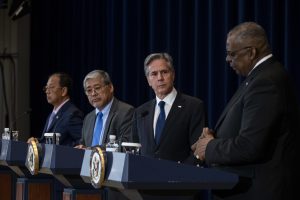The top defense and diplomatic officials from the United States and the Philippines have agreed on a number of measures to modernize and upgrade their bilateral security relationship, consummating a period of rapid advance in relations over the past year.
The announcements came as U.S. Secretary of State Antony Blinken and Secretary of Defense Lloyd Austin hosted Philippine Foreign Affairs Secretary Enrique Manalo and Defense Chief Carlito Galvez in Washington yesterday for the so-called 2+2 meeting.
Chief among the host of measures announced yesterday was the announcement that the countries are in the process of finalizing a road map to cover the delivery of U.S. defense assistance to the Philippines over the coming decade.
In a joint statement, the two sides announced that the “adoption of a Security Sector Assistance Roadmap in the coming months will guide shared defense modernization investments and inform the delivery of priority platforms over the next 5 to 10 years.” This was accompanied by pledges to “strengthen bilateral planning and interoperability to ensure readiness to respond to a range of crises and scenarios.”
According to Reuters, Austin also said that the two sides had discussed the delivery of “priority defense platforms” including radar systems, drones, military transport aircraft, and coastal and air defense systems. The joint statement referenced “discussions on an acquisition plan for a fleet of multi-role fighter aircraft for the Philippine Air Force” and for the use of U.S. military aid to purchase medium-lift helicopters.
The announcements cap a remarkable progress in U.S.-Philippine relations, driven by an overlapping concern about China’s growing power and ambition, in particular its aggressive claim to nearly the entire South China Sea.
At a news conference yesterday, Philippines Foreign Minister Enrique Manalo said that the two sides had “redoubled” their commitment to modernizing the alliance in recognition that “our partnership will need to play a stronger role in preserving an international law-based international order.”
The reference to this “international order” was offered in explicit contrast with recent Chinese actions in the South China Sea. The joint statement underlined the two sides’ “strong objections to the unlawful maritime claims, militarization of reclaimed features, and threatening and provocative activities in the South China Sea.” These included China’s recent attempts “to disrupt the Philippines’ lawful operations at and around Second Thomas Shoal and the repeated massing of PRC maritime militia vessels at several sites within the Philippine Exclusive Economic Zone (EEZ).”
The statement also called on China to “fully comply” with the 2016 arbitral ruling which found that China’s “nine-dash line” claim to the South China Sea had no standing under international law.
Yesterday’s so-called 2+2 meeting was the first to be held since early 2016, prior to the election of Rodrigo Duterte, who for a variety of personal and political reasons initiated a hard turn against the U.S., embracing China’s sales pitch of “no-strings” large-scale infrastructure financing. But since the final year of Duterte’s term, the two sides have more than made up for lost time.
In February, the administration of President Ferdinand Marcos Jr., who took office last July, agreed to allow the U.S. military access to four additional Philippine military bases under the 2014 Enhanced Defense Cooperation Agreement (EDCA). The agreement allows the U.S. rotational access to a select number of military facilities – initially five – nominated by the Philippine government. Under the terms of EDCA, which largely went into abeyance under Duterte, the U.S. military is not permitted to base troops at Philippine facilities permanently, but can use facilities such as runways, fuel storage, and military housing.
Washington had previously announced $82 million for infrastructure upgrades at the five existing EDCA sites, which yesterday’s statement said would rise to more than $100 by the end of 2023. These included support for the “swift operationalization of the four new sites,” which are located in strategic locations: on the northern island of Luzon, close to Taiwan, and on Palawan island, which faces onto the disputed South China Sea.
As if to underscore the rapid strategic convergence between Manila and Washington, yesterday’s 2+2 meeting coincided with the launch of the largest-ever iteration of the annual Balikatan military exercises. The exercises, which run until April 28, will see the participation of more than 17,600 military personnel: 12,200 from the U.S., 5,400 from the Armed Forces of the Philippines, and 111 from Australia.
































